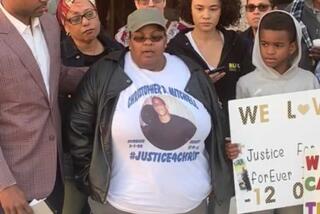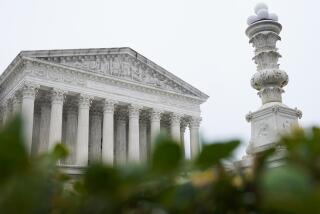Justices mull liability in police chase
WASHINGTON — The Supreme Court justices, hearing arguments on high-speed police chases, signaled Monday that they were likely to shield officers from being sued for ramming a fleeing car and forcing it off the road.
Most of the justices said a speeding car posed an extraordinary danger to other motorists and might justify the use of force to stop the fleeing suspect.
The case has drawn wide attention because of continuing controversy over high-speed police pursuits, in California and elsewhere.
In the case before the court, a fleeing 19-year-old sped a Cadillac through red lights and raced at more than 90 mph on a two-lane road in rural Georgia. He was paralyzed after a police cruiser hit his car and sent it careening over an embankment.
It was “the scariest chase I ever saw since ‘The French Connection,’ ” said Justice Antonin Scalia, describing the police videotape of the chase that was supplied to the court. “It was frightening.... Cars coming in the opposite direction, at night, on a two-lane winding road.”
Several other justices said they too had watched the videotape and were convinced police had acted reasonably when they decided to force the fleeing car off the road.
Over the last decade, most police departments have adopted guidelines to limit these chases because of the danger they pose. Nonetheless, more than 300 people a year die because of high-speed pursuits -- most of them the fleeing motorists, but a substantial number of them bystanders.
Eight years ago, the Supreme Court shielded police from federal lawsuits for recklessly chasing a fleeing motorist. But it left open the possibility of suits against officers who used force to stop a car.
That was the issue the court heard Monday. Victor Harris, the paralyzed driver, sued Coweta County Deputy Sheriff Timothy Scott, alleging that ramming his car amounted to excessive force.
The chase began after dark in March 2001. Harris was clocked going 73 mph on a highway where the speed limit was 55. But when a police officer flashed his blue light, Harris sped away. He was pursued through the parking lot of a small shopping center, where his car and a police car collided.
Undeterred, Harris raced down a winding road, ran red lights, and swerved back and forth across the lanes to avoid other cars.
“Go ahead and take him out,” a police supervisor radioed to Scott. To stop Harris, the deputy rammed the rear bumper of the Cadillac, sending it off the road.
In their comments and questions, the justices indicated they thought the police officer acted reasonably.
“We are talking about 90 miles an hour on a two-lane highway, swerving past cars,” Chief Justice John G. Roberts Jr. said.
Harris “created a tremendous risk for drivers on that road,” Justice Samuel A. Alito Jr. added later.
“How could a jury find otherwise?” Justice David H. Souter said at another point.
In defense of their client, Harris’ lawyers said the young man had been driving “under control” and used his turn signals when changing lanes.
Justice Anthony M. Kennedy replied: “He used the turning signal -- that’s like the strangler who observes the ‘no smoking’ sign.”
Despite the scene on the police video, Harris won two preliminary victories in lower courts.
More than 20 years ago, the high court said an officer could not use “deadly force” to stop a fleeing suspect unless that person posed a true risk to the public or the police. That ruling arose when a police officer, answering a burglary call, encountered a teenager in a backyard and shot him in the head.
In Harris’ case, both a federal judge and the U.S. 11th Circuit Court of Appeals in Atlanta ruled that a jury should hear his claim. These judges said the rule on deadly force should apply to high-speed police chases as well as police shootings.
If that is upheld by the Supreme Court, police might have to let fleeing motorists get away.
But most of the justices suggested Monday that they leaned toward ruling that police may use reasonable force to stop a dangerously speeding vehicle. The decision in Harris vs. Scott is expected in a few months.
Also on Monday, the court agreed to decide whether parents can seek reimbursement for private schooling for a disabled child if the parents decline to try the public school suggested by the school district. The New York City district said public schools should be shielded from paying reimbursements in such cases. The case will be heard in the fall.
And the justices refused to consider an Arizona man’s appeal of a 200-year prison term for possessing child pornography. That state has the nation’s harshest law; each image of illegal pornography can result in 10 years in prison.
The justices have refused to overturn long prison sentences when petitioners have argued that such terms amount to cruel and unusual punishment.
*
More to Read
Get the L.A. Times Politics newsletter
Deeply reported insights into legislation, politics and policy from Sacramento, Washington and beyond. In your inbox three times per week.
You may occasionally receive promotional content from the Los Angeles Times.











